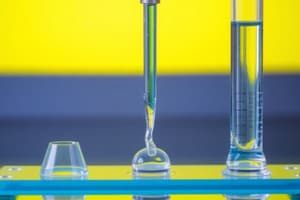Podcast
Questions and Answers
What is the reciprocal of viscosity in a Newtonian system?
What is the reciprocal of viscosity in a Newtonian system?
Fluidity (f)
What type of rheometer is required to fully characterize a non-Newtonian system?
What type of rheometer is required to fully characterize a non-Newtonian system?
Multipoint rheometer
What is the name of the materials that exhibit plastic flow?
What is the name of the materials that exhibit plastic flow?
Bingham bodies
What is the equation that describes plastic flow?
What is the equation that describes plastic flow?
What is the significance of the yield value in plastic flow?
What is the significance of the yield value in plastic flow?
What is the name of the curve that represents the flow behavior of non-Newtonian systems?
What is the name of the curve that represents the flow behavior of non-Newtonian systems?
What is the characteristic of pseudoplastic flow?
What is the characteristic of pseudoplastic flow?
What is the rheological property of suspensions that is affected by particle size and concentration?
What is the rheological property of suspensions that is affected by particle size and concentration?
What is the characteristic of a Newtonian fluid in terms of its viscosity?
What is the characteristic of a Newtonian fluid in terms of its viscosity?
What is the main difference between a Newtonian and a Non-Newtonian fluid?
What is the main difference between a Newtonian and a Non-Newtonian fluid?
What is a rheogram, and what does it represent?
What is a rheogram, and what does it represent?
What is the characteristic of a dilatant fluid?
What is the characteristic of a dilatant fluid?
What is plastic flow, and what is its characteristic in terms of yield value?
What is plastic flow, and what is its characteristic in terms of yield value?
What is the characteristic of a pseudoplastic fluid?
What is the characteristic of a pseudoplastic fluid?
What is the significance of the rheological properties of suspensions?
What is the significance of the rheological properties of suspensions?
What is the purpose of plotting a viscosity function?
What is the purpose of plotting a viscosity function?
What is the potential drawback of processing dilatant materials under conditions of high shear?
What is the potential drawback of processing dilatant materials under conditions of high shear?
What concentration of small, deflocculated particles is required for a suspension to exhibit dilatant flow properties?
What concentration of small, deflocculated particles is required for a suspension to exhibit dilatant flow properties?
What is the behavior of quicksand when subjected to increased strain rate?
What is the behavior of quicksand when subjected to increased strain rate?
What is the term for the time-dependent viscosity of a system?
What is the term for the time-dependent viscosity of a system?
What is the term for the breakdown of structure in a shear-thinning system?
What is the term for the breakdown of structure in a shear-thinning system?
What is the behavior of a pseudoplastic system when stress is removed or reduced?
What is the behavior of a pseudoplastic system when stress is removed or reduced?
What is the term for the minimum stress required for a material to flow?
What is the term for the minimum stress required for a material to flow?
What is the behavior of a mixture of cornstarch and water (Oobleck) when subjected to a force?
What is the behavior of a mixture of cornstarch and water (Oobleck) when subjected to a force?
Flashcards are hidden until you start studying
Study Notes
Newtonian Liquids
- Named after Sir Isaac Newton, these fluids are the simplest type of fluid.
- Characterized by constant viscosity, regardless of the shear rates applied.
- Shear stress is directly proportional to the shear rate.
- Examples: water and oil.
Non-Newtonian Liquids
- Viscosity changes with the shear rate.
- Fail to follow Newton's equation of flow.
- Examples: colloidal solutions, emulsions, liquid suspensions, and ointments.
- Three general types: Plastic, Pseudoplastic, and Dilatant.
Rheogram
- A plot of shear rate (G) as a function of shear stress (F).
- Also known as consistency curves or flow curves.
- Describes the rheologic properties of a given material.
- The simplest form is produced by Newtonian systems.
- The slope, f, is known as fluidity and is the reciprocal of viscosity, η.
Plastic Flow
- Exhibited by materials known as Bingham bodies.
- Flow curves do not pass through the origin but intersect the shear stress axis at a particular point (yield value).
- A Bingham body requires a certain amount of shear stress (yield value) before it begins to flow.
- The slope of the rheogram is termed the Mobility, and its reciprocal is known as the plastic viscosity, U.
Dilatant Flow
- Exhibited by substances possessing dilatant flow properties, such as suspensions containing a high concentration of small, deflocculated particles.
- Examples: Corn starch and water mixture (oobleck), which acts as a solid and resists force when a force is applied.
Thixotropy
- Viscosity of a system depends on both shear rate and time.
- Non-Newtonian systems can exhibit hysteresis loops, where the down curve is displaced relative to the up curve.
- Examples: plastic and pseudoplastic systems.
Studying That Suits You
Use AI to generate personalized quizzes and flashcards to suit your learning preferences.



